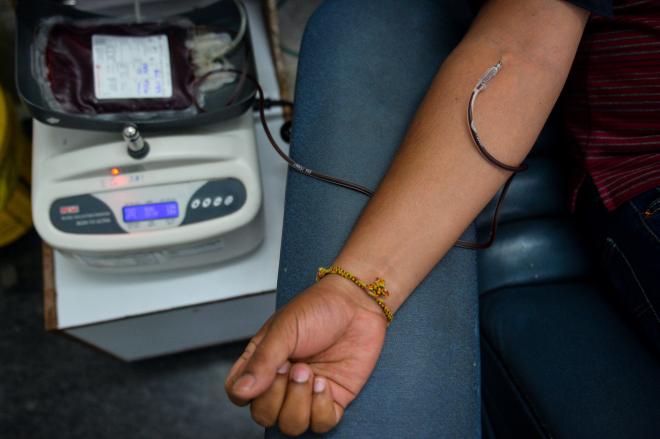World Blood Donor Day 2016: 5 Things You Need To Know Before Donating Blood
As someone who is O negative — the blood type most often requested by hospitals — I have made dozens of donations. Type O is always in demand and in great supply because it can be transfused to patients of all blood types, according to the American Red Cross. While approximately 38 percent of the U.S. population is also eligible to donate, only 10 percent actually do. Enter World Blood Donor Day.
The World Health Organization (WHO) holds the campaign every year on June 14 to “thank blood donors for their life-saving gift of blood,” as well as to raise awareness surrounding the need for regular donation. Someone in the U.S. needs blood every two seconds, which adds up to roughly 36,000 units of red blood cells every day. While nearly 7 million Americans will volunteer each year, the unavailability of blood still leads to deaths and many patients suffering from ill health, WHO reported. And in 2011, WHO found that national blood supplies were based on 100% or almost 100% voluntary unpaid blood donations in 62 countries.
That said, such an altruistic act requires a certain level of precaution and preparation in order to make the donation as successful and painless as possible. Twenty-five percent of us will require a blood transfusion at some point in our lives, and the American Red Cross and other organizations have a few guidelines in place to make sure both donors and their sample are eligible and healthy.
Here’s what you need to know.
1. CHECK TO SEE IF YOU’RE ELIGIBLE
Blood banks may be in high demand for blood, but they won’t take just anyone. Most states require individuals be at least 17 years old and weigh at least 110 pounds — if not, they could be turned away. People may also be ineligible if they recently got a tattoo, travel out of the United States, have risky sex, low blood pressure, or anemia. In the case of the latter, the person drawing your blood will prick your finger to ensure iron levels are high enough for a safe donation. Many gay, bisexual, and transgender man are still prohibited from donating blood despite the FDA’s repeal of a 30-year lifetime ban, as well. Though if you can’t donate for something you can’t necessarily control, like anemia, a financial donation can be equally helpful.
2. MAINTAIN IRON LEVELS
If you’re confident you’re an eligible donor, search for the nearest donation center through the Red Cross. Bring a government-issued ID with you, like a drivers license, passport, or birth certificate; a list of the medications you’re currently taking; and be sure to eat a meal that’s low in fat and high in iron an hour before you’re set to give blood. White or wheat bread, non-fat yogurt, eggs, spinach, and bananas are all good foods to choose from. It’s important to have your blood flowing at top caliber; high iron levels keep you alert and less at risk for fainting. But just in case, ask a friend or family member to go with you so you don’t have to worry about driving home afterwards.
3. SQUEEZE
Roll up your sleeves and let the trained healthcare professional prep your arm. They’ll ask you to squeeze a ball in order to get more blood pumping through your veins, which makes it easier to find an eligible vein. Once you’ve been cleaned with iodine, a sterile needle is inserted into the crock of your elbow for up to 12 minutes or until roughly one pint of blood and a few test tubes are drawn. For donors who have afear of needles, now’s the time to bring out any distractions you brought along: a book, calming playlist, or even topics of conversation for health personnel. Otherwise keeping your eye on the prize, the lives your blood could affect, can help get you through it.
4. COOL DOWN
The tubes may be filled, but you’re not done yet. The area where the needle went in may be bruised and require an ice application within the first 24 hours to reduce swelling or discoloring. You’ll be ushered over to a station where snacks, juices, and water bottles are provided to help keep your sugar levels up and prevent you from feeling dizzy.
5. DRINK PLENTY OF FLUIDS
Your blood will undergo more than a dozen tests to screen for any diseases or abnormalities. If something is found, the blood is discarded and the donor is contacted. But when you leave the actual day of donation, avoid arduous exercise or heavy lifting and remember to drink plenty of fluids. It’s also a good idea to avoid caffeinated or alcoholic beverages, as they dehydrate the body. And if you were able to conquer your fear and, dare we say, enjoy the experience, don’t rush to make another appointment. You’ll have to wait at least eight weeks between donations, sometimes longer depending upon your weight and health. Generally speaking, those training for marathons or other intensive activities should wait until after the race.








